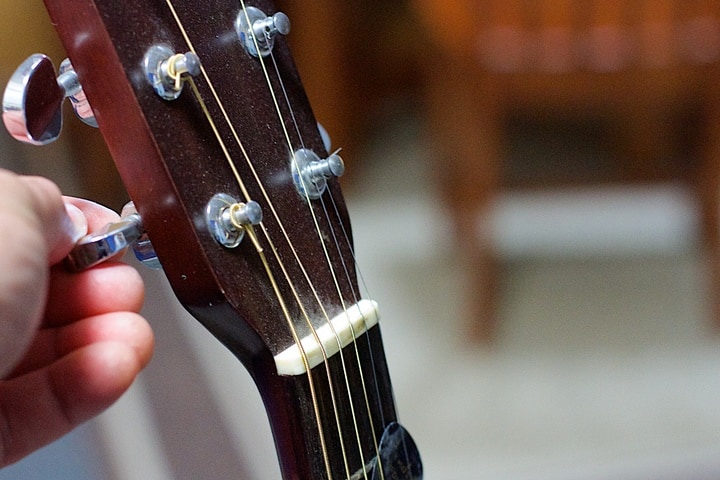When you start playing guitar you may not be aware of the existence of any tuning apart from E standard.
After some time getting along with the instrument, you will be able to notice that you could achieve lower pitches just by tuning your strings down.
Once you discover this amazing issue you won’t stop doing it, you will learn a bunch of songs with those new tunings but you wonder if your guitar is suffering from these changes.
Although it could be such a confusing topic, I will answer this question for you.
In short, it is not wrong or right to change guitar tunings too often. However, you should know that on some occasions and depending on the tuning, your guitar will need some adjustments.
You may wonder, do I have to set up my instrument every time I change tuning?
My guitar would be damaged if I so that?
Don’t worry! Relax and take a look at this article.
Through this article, I will try to explain everything related to this aspect plus I will evacuate any doubts that could come up.
Let’s dive deeper into this topic, in the end, you will be an expert regarding different tuning consequences and you won’t be confused anymore!
Can a guitar be damaged by changing tunings often?
If you are a guitar player who likes to experiment with different tunings you will be able to do it without having any problems.
Some players think that if you change between tunings too often you can damage your instrument but let me tell you that is not the case.
As a matter of fact, is almost impossible to happen unless you do something extreme to your instrument or something extremely stupid such as putting bass strings on your guitar, or try tuning way higher than standard.
Although, your instrument will probably still be safe for that latter stupidity since strings will probably snap first.
Having said that I want to mention that to tune properly you should go from down to up to avoid string slack.
If you try to do it the other way around you might have tuning problems.
That is because by tuning up to down you can leave the strings loose, resulting in poor intonation, and creating string slack at the nut giving the chance for your guitar to easily go out of tune.
We have more information about this interesting topic in one of our articles. If you are curious, here you have the link to it:
Will it still be ok if you change string gauges alongside tunings often?
Changing your guitar strings is something you should regularly do, maybe every three months at least.
As it is a task related to the proper maintenance of the instrument it won’t damage at all, it will be better for it instead.
But what happens if you change the string gauge with respect to the one you were using?
Well, contrarily as you may think, it won’t be harmful to your guitar in any way.
These instruments are designed to work with any kind of string no matter the gauges.
However, your instrument could need a setup when installing a thicker string set.
That is because you are adding more tension to the piece and it may require some adjustments, although is something that it might occur, is not always the case.
Finally, I want to say, that it’s possible that the effect of changing string gauge would be physically neutral to the instrument if you at the same time go for a different tuning.
For instance, thicker strings with a lower tuning could probably match the tension exerted on the neck by thinner strings at a higher tuning, requiring no adjustments at all.
What could happen to your guitar if you keep changing tunings?
As the guitar is a truly versatile instrument, various tuning may be tried out but if you move too much or often between different tunings, at some point your guitar might need a setup.
That mainly affects the piece, especially when making a radical change in tension.
But how can I realize that my guitar needs some adjustments?
Well, some signs show your guitar requires a setup. If your instrument experiences intonation issues, too high action, problems to keep it in tune, buzzings, vibrations, or warped neck it has to be serviced.
Do different tunings take some time to really settle?
Another remarkable aspect regarding tunings is that they might take a while to settle, in some cases, you will have to change strings or even go to a music store to have your guitar adjusted.
These situations may occur when going for a far different tuning such as standard D or C, not only the string but also the instrument itself will require some time to get used to the new tension, what is more, you will notice that keeping the tuning will be hard at first.
Not all tunings are as hard on the guitar
Even though changing between widely different tunings is something that affects your guitar, moving just a bit won’t require any neck adjustments.
For instance, going from E standard to drop D or a half step down won’t be such a radical change and it won’t influence your instrument but, if you go for a lower tuning, maybe a whole step down or more, a setup might be needed.
It’s not the actual tunings, it’s the differences in string tension and neck relief
Although we have discussed a lot about the possible inconveniencies when going between tunings, is not the tuning itself the main problem of this aspect.
Actually, what does cause trouble is the change in tension pulling the neck, resulting in neck relief, uncomfortable string action, fret buzz among others.
To balance a lower tuning you could install thicker strings which will generate extra tension plus everything would be balanced out.
The same principle may be taken into account when doing it the other way around, tuning half step down with thinner strings.
However, try not to think of this as a table of equivalences because it doesn’t work that way.
As each instrument is different, you should test tunings with diverse string gauges, see how they feel and how the guitar reacts.
Would you need to set up your guitar every time you change tunings?
Contrarily you may think, it is not necessary to set up your instrument every single time you vary tunings.
Although in some cases a setup might be required, is not something you must do strictly when changing them.
Make your guitar set up only if you notice any of the previously explained signs.
However, if you feel curious about this issue and you want to know more about it, we have a wonderful article in which we break down that topic!
If you usually move between a few tunings, consider getting more guitars
When watching guitar players perform on stage you may notice that they change guitars between songs, that is not only because they want to get a different tone but also because they may not be using the same tunings through all songs.
It is not eccentric conduct, if you tend to change between various tuning, you should consider getting more guitars.
Probably not for going from standard to drop D, that is something you can easily and fastly do.
But if you play songs in E standard, some open tuning, and standard D or C, it would be wise to get specific guitars for each of those tunings down the line.
In that way, you won’t have to be adjusting your instrument all the time, your instrument will be in tune plus you will save time on stage.

Hello there, my name is Ramiro and I’ve been playing guitar for almost 20 years. I’m obsessed with everything gear-related and I thought it might be worth sharing it. From guitars, pedals, amps, and synths to studio gear and production tips, I hope you find what I post here useful, and I’ll try my best to keep it entertaining also.





